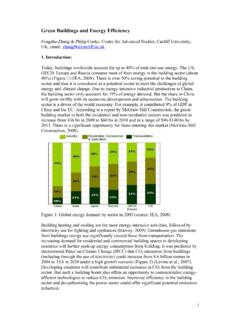Transcription of BIS Working Papers
1 BIS Working Papers No 656. Demographics will reverse three multi-decade global trends by Charles Goodhart and Manoj Pradhan Monetary and Economic Department August 2017. JEL classification: J11, J18, E43, D63, E31, H63. Keywords: demography, global labor supply, ageing, real interest rates, inequality BIS Working Papers are written by members of the Monetary and Economic Department of the Bank for International Settlements, and from time to time by other economists, and are published by the Bank. The Papers are on subjects of topical interest and are technical in character.
2 The views expressed in them are those of their authors and not necessarily the views of the BIS. This publication is available on the BIS website ( ). Bank for International Settlements 2017. All rights reserved. Brief excerpts may be reproduced or translated provided the source is stated. ISSN 1020-0959 (print). ISSN 1682-7678 (online). Foreword The 15th BIS Annual Conference took place in Lucerne, Switzerland, on 24 June 2016. The event brought together a distinguished group of central bank Governors, leading academics and former public officials to exchange views on the topic Long-term issues for central banks.
3 The Papers presented at the conference and the discussants' comments are released as BIS Working Papers 653 to 656. BIS Papers no 92 contains the opening address by Jaime Caruana (General Manager, BIS) and remarks by Kevin Warsh (Hoover Institution and Stanford Graduate School of Business). WP656 Demographics will reverse three multi-decade global trends iii Demographics will reverse three multi-decade global trends Charles Goodhart . Manoj Pradhan . Abstract Between the 1980s and the 2000s, the largest ever positive labour supply shock occurred, resulting from demographic trends and from the inclusion of China and eastern Europe into the World Trade Organization.
4 This led to a shift in manufacturing to Asia, especially China; a stagnation in real wages; a collapse in the power of private sector trade unions; increasing inequality within countries, but less inequality between countries; deflationary pressures; and falling interest rates. This shock is now reversing. As the world ages, real interest rates will rise, inflation and wage growth will pick up and inequality will fall. What is the biggest challenge to our thesis? The hardest prior trend to reverse will be that of low interest rates, which have resulted in a huge and persistent debt overhang, apart from some deleveraging in advanced economy banks.
5 Future problems may now intensify as the demographic structure worsens, growth slows, and there is little stomach for major inflation. Are we in a trap where the debt overhang enforces continuing low interest rates, and those low interest rates encourage yet more debt finance? There is no silver bullet, but we recommend policy measures to switch from debt to equity finance.. London School of Economics.. Talking Heads Macro. WP656 Demographics will reverse three multi-decade global trends 1. Introduction The global economy over the last 35 years has experienced three significant trends; a decline in real interest rates (supporting asset prices), a drop in real labour earnings in advanced economies (AEs), and, perhaps most startling of them all, a meteoric rise in inequality within countries alongside a drop in inequality between them.
6 All three trends have been researched extensively, but individually, locally and independently from one another. We argue that such an analysis is the wrong approach. Instead, we believe all three trends need to be examined together in a global context. Specifically, we argue that demographic developments over the last 35 years have driven falling real interest rates, inflation and wages, and rising inequality within countries as well as some of the falling inequality between AEs and emerging market economies (EMEs). Can demographics really explain all three trends? If we include the integration of the gigantic labour forces of China and eastern Europe into the global economy, then global demographic dynamics do help to explain all three trends.
7 But if that is correct, then the demographic reversal that the global economy will witness over the coming decades will also reverse the fall in real interest rates and inflation, while inequality will fall. We approach the critical role of demographics differently from previous studies in three specific ways. First, we attach a great deal of importance to the role of China, both in the past and future. Second, we argue that the political economy of the social safety net in AEs will play a critical role in driving our results. Third, in an extension of our first point, we take what we think is a truly global approach to the discussion of demographics, looking collectively at the global labour supply and the global prices of labour and capital.
8 By contrast, much of the literature that looks at demographics in an international context examines local demographic dynamics of two (or more). economies and then discusses spillovers to and from neighbouring economies. We make our argument in five parts. The first section details the extraordinary demographic dynamics we have seen over the last 35 years and their impending reversal. The second and third sections explain our main propositions why real interest rates will rise thanks to ageing, and then why wages and inflation will rise, while inequality will fall amidst a political confrontation between the elder cohorts and the prime Working age population.
9 Section 4 looks at contrasting evidence from other research as well as from the experience of Japan and north Asia. Finally, the last section looks at the prospective changes that could mitigate (or overturn, as some may argue) some of the effects of ageing ie the rise of India and Africa, greater participation of the elderly, and debt. 1. The demographic sweet spot slowly turning sour The demographic sweet spot . The demographic sweet spot of the 1970s and 1980s started with falling birth and fertility rates. World population grew fast, at nearly 2% per year until about 1990.
10 (Graph 1). Then, as birth rates and fertility rates in both AEs and EMEs fell (Graph 2), world population growth slowed to about per year until about now. World 2 WP656 Demographics will reverse three multi-decade global trends population growth in 2040 will, however, be higher either than in AEs or our categorisation of the EMEs, because there is yet another category of countries . defined as the least developed regions and countries, mostly in Africa 1 where population growth is predicted by the UN to remain much higher through 2040. World population growth will slow even further In per cent Graph 1.
















